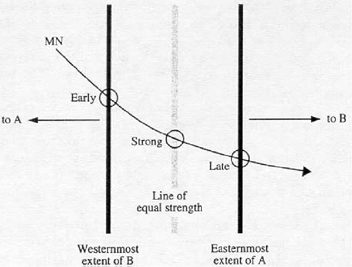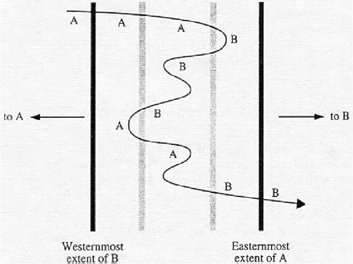"Reduced Cell Switching in a Mobile Computing Environment"
Summary by Andy Reitz.
February 20th, 2001
Introduction:
Mobile
IPv4 provides a framework in which a host my change IP
networks, but still maintain transparent connectivity to
its home network. However, Mobile IPv4 imposes a severe penalty
for mobility -- the Mobile
Host (MH) must send an update message to its Home
Agent (HA) every time it changes location. Since these
updates are themselves IP based, they are subject to latency,
loss, etc. To further compound these problems, the Mobile IPv4
standard doesn't explicitly state when a Mobile Host
should change it's registration. It is conceivable that a Mobile
Host may be in contact with two different access points
simultaneously. In this situation, when is it beneficial to
change access points (hence causing an update), and when is it
prudent to stick with the current access point? This paper
attempts to resolve these questions.
Cell Switching in Mobile IPv4/Mobile IPv6:
Mobile IPv4 suggests two different cell switching algorithms,
but doesn't mandate a standard algorithm, nor does it mandate
when such an algorithm should be used. In the first algorithm,
the MH determines that it has entered a new cell if it misses
several advertisements from it's old base station. In the second
algorithm, the MH determines that it has changed cells by
examining the IP network of the base station updates. A change
in broadcast domain indicates that the MH is in a new cell, and
it should attempt to establish a connection to the new base
station.
One flaw with both of these algorithms is that they do not
notice when the MN loses contact with the base station. Wireless
communications are not necessarily symmetric -- simply because
the MH is receiving updates from its chosen base station,
doesn't mean that it is still able to send data to said base
station. Mobile IPv6 corrects some of these deficiencies by
specifying three algorithms for a base station to verify that it
can reach a MH. Furthermore, two algorithms are specified for
the MH to determine if it can reach the base station. Typically,
of these algorithms, there are one or two well performing
ones, and one slow, last resort algorithm per group. This
paper seeks to improve these algorithms, to achieve less cell
switches, and a stronger signal on average.
Simple Cell Switching Techniques:
The key assumption of this paper is that in the wireless world,
the coverage areas of base stations will overlap, creating an
area where a MH has a choice regarding which base station it
connects to. Thus, in this sort of environment, there are three
simple techniques that can be used in order to prompt a change
of base station:
- Late Cell Switching (Late) - Switch when moving out
of the overlap area, so that contact can only be established
with one base station.
- Early Cell Switching (Early) - Switch when first
entering the overlap area.
- Strong Cell Switching (Strong) - By using special
link-layer information, switch when the signal from the new
base station becomes stronger than the current base
station.
The following diagram describes these three techniques, if a MH
were moving from cell A to cell B:
 The performance of each of these techniques varies depending
upon the movement of the MH. For example, if the MH
always moves as in the picture (a user on a train), then
Strong would provide the best performance. However, each of
these techniques has a fairly tight degenerate region. A
degenerate region is a space such that every time the MH crosses
into it, a base station switch occurs. Thus, in the Early
switching example, if the MH were to repeatedly cross the
"westernmost extent of B" line (by moving into the overlap, back
into A, and so on), a vast number of update messages would be
generated. Because these degenerate regions are so easy to fall
into, alternative techniques must be investigated in order to
ensure adequate performance.
The performance of each of these techniques varies depending
upon the movement of the MH. For example, if the MH
always moves as in the picture (a user on a train), then
Strong would provide the best performance. However, each of
these techniques has a fairly tight degenerate region. A
degenerate region is a space such that every time the MH crosses
into it, a base station switch occurs. Thus, in the Early
switching example, if the MH were to repeatedly cross the
"westernmost extent of B" line (by moving into the overlap, back
into A, and so on), a vast number of update messages would be
generated. Because these degenerate regions are so easy to fall
into, alternative techniques must be investigated in order to
ensure adequate performance.
Complex Cell Switching with Hysteresis:
Drawing inspiration from the cellular telephone network (where
cell switching techniques were originally pioneered), the
authors observed that the technique of hysteresis could
be used in this environment. Hysteresis entails inducing a
switch of base station only a difference in signal
strength exceeds some sort of preset value. Thus, a
hysteresis region will be setup, around the area of equal
strength. This region prevents excessive cell switching, as well
as doesn't do so at the expense of reliable wireless
communication. Using this technique, the floor is opened for
three more algorithms:
- Late-SH - Late with static hysteresis. When the MH
reaches a far border of the hysteresis region, it changes base
stations.
- Strong-SH - Strong with static
hysteresis. Maintains the "Strong" line, in the middle of the
hysteresis region. Strong-SH behaves similarly to Late-SH,
except that the MH will only switch cells after passing the
middle line and a hysteresis boundary.
- Strong-DH - Strong with dynamic hysteresis. Same as
Strong-SH, except the hysteresis boundaries change dynamically
depending on MH movement.
The following diagram depicts the Late-SH technique in action:
 As shown above, the MH has to cover a wide area in order to
reach a degenerate state, in which it is constantly changing
base stations. This is quite desirable, and will vastly improve
the performance of Mobile IP.
As shown above, the MH has to cover a wide area in order to
reach a degenerate state, in which it is constantly changing
base stations. This is quite desirable, and will vastly improve
the performance of Mobile IP.
Conclusion:
The driving force behind this paper is that reasonable
performance can be achieved with Mobile IP, if the proper cell
switching techniques are used. Furthermore, the techniques
specified in both Mobile IP standards are
inadequate. Similarly, because wireless data networks are
inherently different than the cellular voice network, the
"proven" cellular techniques (Late-SH) won't provide the best
performance for a Mobile IP environment, which will typically
rely on smaller cells.
The authors attempt to backup these claims with some performance
measurements. In these measurements, the authors find that the
Late-SH technique has the minimal switching cost, it also has
poor signal strength for some types of movement. Basically, with
Late-SH, the MH could spend a long time close to the far edge of
the hysteresis region, maintaining a poor connection to
its old base station. They go on to find that the Strong
techniques (Strong-DH in particular) excel at the signal quality
metrics. However, they also find that Strong-DH will incur more
cell switches than Late-SH. The authors conclude by stating that
the extra cell switching cost is justified. Thus, the Strong-DH
technique represents the best balance of signal strength versus
number of cell switching costs.
References:
- Reduced Cell Switching in a Mobile Computing Environment
http://dev.acm.org/pubs/articles/proceedings/comm/345910/p143-camp/p143-camp.pdf
- Mobile Networking Through Mobile IP: A Tutorial
http://www.computer.org/internet/v2n1/perkins.htm
- IETF Mobile IP Working Group
http://www.ietf.org/html.charters/mobileip-charter.html

